SONY DW-Q30A
2. Reading Tests
Review Pages
2. Reading Tests
3. CD Error Correction Tests
4. DVD Error Correction Tests
5. Protected Disc Tests
6. CD Recording Tests
7. CD Writing Quality - Plextools
8. CD Writing Quality - Clover System
9. DVD Recording Tests
10. DVD Writing Quality - Page 1
11. DVD Writing Quality - Page 2
12. DVD Writing Quality - Page 3
13. DVD Writing Quality - Page 4
14. DVD Writing Quality - Page 5
15. DVD Writing Quality - Almedio
16. DVD+R DL - Page 1
17. DVD+R DL - Page 2
18. BookType Setting
19. DW-Q30A vs SA300 - Page 1
20. DW-Q30A vs SA300 - Page 2
21. DW-Q30A vs SA300 - Page 3
22. DW-Q30A vs SA300 - Page 4
23. Firmware Hacks
24. Conclusion
- CD Format
![]() For
our CD transfer rate (reading) tests, we used the Nero CDSpeed utility and a
set of both Pressed and CDR media. Let's take a look at how the Sony drive performed
compared with the other two drives.
For
our CD transfer rate (reading) tests, we used the Nero CDSpeed utility and a
set of both Pressed and CDR media. Let's take a look at how the Sony drive performed
compared with the other two drives.
Note that you have to press the eject button for a few seconds, until the drive's activity led blinks twice, in order to set the drive to 48X reading speed. This is a procedure you'll have to repeat each time you open/close the drive's tray, otherwise it reverts back to 40X.
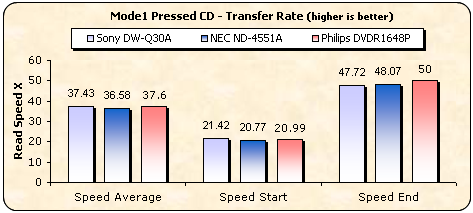
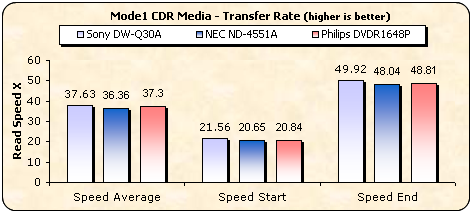
All drives support the same maximum reading speed for the CD format, that of 48X. Their performance as reported by CDSpeed was similar with the SONY drive being a little faster.
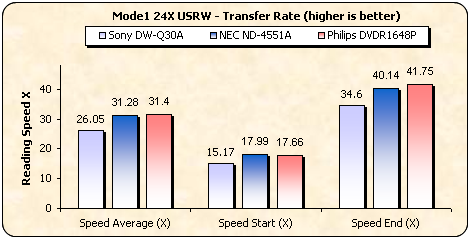
Despite boasting 48X reading speed, the Sony drive seems to could only manage 34.6X maximum reading speed with RW media.
- AudioCD
For this tests we used a pressed AudioCD and its copy on a CD-R.
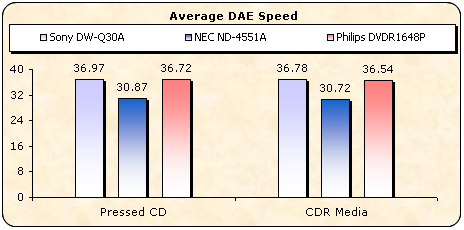

When reading AudioCDs, the NEC drive supports 40X DAE speed while the Philips and SONY 48X. All drives managed a perfect score of 100 in Nero's Advanced DAE Quality Test.
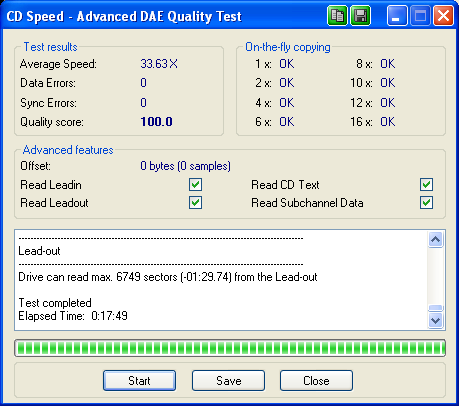
Below is the graph of 90min test disc which we stopped trying to play/rip due to the very slow speed of 0.8X~1X.


The Q30A failed to read the 99min test disc and it reported an error just before the end of the disc.
- DVD Format
![]() Now
let's have a look at how the drive performs with DVD media. Again, a set of
DVD media was used, both SL and DL.
Now
let's have a look at how the drive performs with DVD media. Again, a set of
DVD media was used, both SL and DL.

Same specifications for all drives and hence, similar performance. All reached the 16X maximum reading speed.
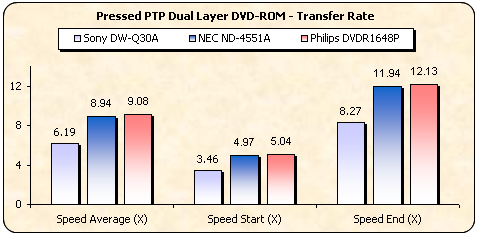
The two layers of a PTP DVD-ROM disc are read sequentially with the drive starting reading from the inner part of the disc, which is the beginning of each layer, progressing towards its outer range. NEC and Philips reported similar performance, with 12X support, while the SONY supports up to 8X.

The first layer of an OTP dual layer DVD-ROM is read exactly the same way as the first layer of the PTP disc we tested previously, the main difference being the reading strategy of the second layer on the disc. The beginning of the second layer is located in the outer part of the disc, so the drive starts reading from the outer tracks towards the inner part of the disc. Again, the Sony drive supports up to 8X reading.


The supported reading speeds for DVD±RW are the same for all tested drives. In the case of DVD±R, the NEC is the fastest since it supports 16X while the SONY and Philips drives support 12X for the same formats.

Average ripping performance from the Sony and NEC drives. Only the Philips drive offers a high ripping transfer rate.
-Appendix
Nero CD-DVD Speed Graphs
CD Pressed / CD-R / US-RW / AudioCD / AudioCD-R
DVD Pressed SL / DVD Pressed DL PTP / DVD Pressed DL OTP / DVD-R / DVD-RW / DVD+R / DVD+RW
Review Pages
2. Reading Tests
3. CD Error Correction Tests
4. DVD Error Correction Tests
5. Protected Disc Tests
6. CD Recording Tests
7. CD Writing Quality - Plextools
8. CD Writing Quality - Clover System
9. DVD Recording Tests
10. DVD Writing Quality - Page 1
11. DVD Writing Quality - Page 2
12. DVD Writing Quality - Page 3
13. DVD Writing Quality - Page 4
14. DVD Writing Quality - Page 5
15. DVD Writing Quality - Almedio
16. DVD+R DL - Page 1
17. DVD+R DL - Page 2
18. BookType Setting
19. DW-Q30A vs SA300 - Page 1
20. DW-Q30A vs SA300 - Page 2
21. DW-Q30A vs SA300 - Page 3
22. DW-Q30A vs SA300 - Page 4
23. Firmware Hacks
24. Conclusion





















